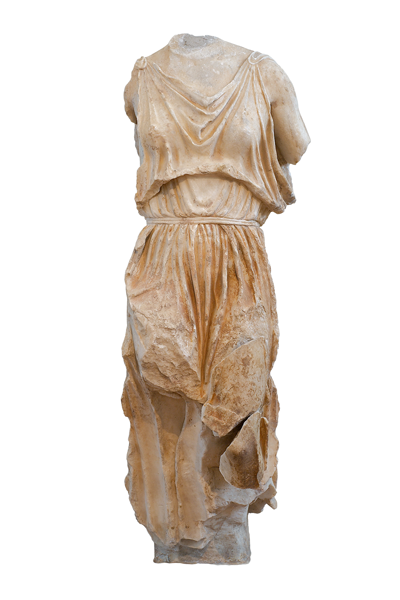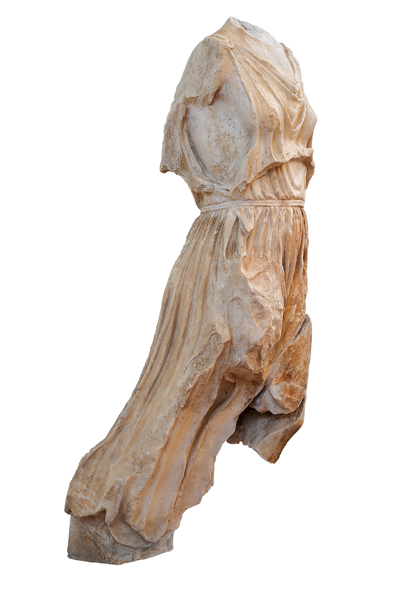Exhibit of the month
A peplos for Athena …
Headless statue of a peplophoros
National Archaeological Museum
Sculpture Collection, inv. no 1732
Provenance: found northeast of the Theseion, at the site of the Ancient Agora of Athens
Dimensions: Height: 1 m
Date: circa 440 BC
Display location: Room 17
The female figure moves forward intensely, creating the impression that she flies, a fact that is further emphasized by the garment which is depicted flowing behind her legs. The figure is dressed in a peplos with an apoptygma (overfold) adhering to the youthful body, thereby revealing its curves, and is pushed between her thighs by the blowing wind. The lack of wings on her back prevents us from identifying the figure with Nike. Therefore, the depicted woman is someone else, possibly an Aura, the companion of the goddess Artemis, or Hebe. The latter was daughter of Zeus and Hera who married the hero Heracles after his apotheosis and rise to Mount Olympus. She symbolized the beauty and joy of youthfulness. The statue possibly served as the central acroterion mounted on one of the pediments of the temple of Ares in the Ancient Agora.
The peplos was the typical attire for women already since the Daedalic period (7th c. BC), a time in which monumental sculpture emerged. It was a heavy, thick dress, likely made of wool, fastened over the shoulders with pins and bound tightly at the waist by a belt. Evidently, during the Archaic period the lightweight Ionic chiton with the himation were preferred, as opposed to the peplos, which nonetheless regained its popularity from the early Classical period onwards[1]. The upper part of the garment was folded over into an apoptygma(overfold) and belted over or beneath it, forming rich pleats that covered the legs preventing the outline of the body to be revealed. As a rule, one side of the garment was not sewn and, as a result, a part of the body of the usually young person who wore it was revealed. This particularity of the dress, that enabled greater freedom of movement, turned it popular in depictions of youthful figures with vigorous movement, as in the case of the statue under consideration, but also in representations of Nike and Amazons. Often in such figures the sculptors took advantage of the intense movement of the body so as to render the garment as having slipped from the shoulder, exposing one of the breasts.
The virgin goddess Athena is always depicted clad in a peplos. The sacred garment, that was woven by the arrhephoroi and the ergastines, was the focal point of the ritual that took place on the last day of the Panathenaea festival, as it was transported attached to the mast of a ship-cart in a procession to the Sacred Rock of the Acropolis and was delivered to the xoanon of the goddess. The magnificent procession that carried the peplos is depicted on the Parthenon Frieze.
[1] The revival of the austere peplos in the Early Classical period has been attributed either to limitations placed on the use of the Ionic chiton, as a conscious rejection of anything that could be construed as Persian-friendly after the Persian Wars, or to religious reasons, especially because of its use in the Panathenaea festival.
Dr Chrysanthi Tsouli
Bibliography:
C. Brons, Gods and garments: Textiles in Greek sanctuaries in the 7th to the 1st Centuries BC, Oxford 2016.
A. Delivorrias, Attische Giebelskulpturen und Akrotere des funften Jahrhunderts, Tubingen 1974, 122 κ.ε., πίν. 39.
M. Lee, Body, dress and identity in ancient Greece, Cambridge 2015.
Roccos, L.J., 2000. Back-Mantle and Peplos: The Special Costume of Greek Maidens in 4th-Century Funerary and Votive Reliefs. Hesperia 69.




